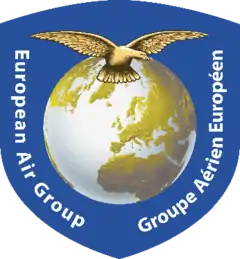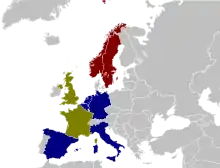European Air Group
The European Air Group (EAG) is an independent defence organisation, formed by the Air Forces of its seven member states: Belgium, France, Germany, Italy, Netherlands, Spain and the United Kingdom. The EAG is focused on improving interoperability between the air forces of EAG and partner states.[3][4][5][6]

 | |
| Abbreviation | EAG |
|---|---|
| Formation | 6 July 1998[1] |
| Type | International organization[1] |
| Headquarters | RAF High Wycombe, United Kingdom[1] |
Membership | Belgium Germany France Netherlands Italy Spain United Kingdom[2] |
Director | Lieutenant General Andrė Steur (RNLAF) |
| Website | euroairgroup |
History
The origins of the EAG extend back to the 1991 Gulf War, during which the United Kingdom's Royal Air Force (RAF) and France's Armée de l’Air (French Air Force or FAF) worked closely together on a range of operations. Subsequently, the two Air Forces collaborated again, this time on missions in support of United Nations forces in the former Yugoslavia and in operations over Bosnia-Herzegovina.
As a result of these experiences, both France and the UK realised that to improve their level of interoperability, a new organization was needed that would provide focus and momentum. Consequently, the intention to form the Franco-British European Air Group (FBEAG) was announced at the Chartres Summit in 1994 and the FBEAG was formally inaugurated at a joint ceremony involving French President Jacques Chirac and British Prime Minister John Major the following year. From the start, the word ‘European’ was included in the organisation's title, to enable other potential members to join the initiative.
As the FBEAG evolved, it was decided that other states would be invited to become ‘correspondent’ members, which became the catalyst for a more permanent arrangement. Italy became the first new state to apply for membership, soon to be followed by others, and on 1 January 1998, the name of the FBEAG was changed to ‘the European Air Group’ (EAG). Shortly afterwards, the new Headquarters Building was formally opened at RAF High Wycombe in June 1998 by the UK Secretary of State for Defence, the Right Honourable George Robertson MP, who the following year became the Secretary General of NATO.
The new EAG was formally endorsed by the Ministers of France and the UK, Alain Richard and George Robertson, who jointly signed the Inter-Governmental Agreement on 6 July 1998. This date marks the formal start point of the EAG, which rapidly expanded under an Amending Protocol[2] signed on 16 June 1999 to allow the accession of new members and reach its current composition of seven member states: Belgium, France, Germany, Italy, Netherlands, Spain and the United Kingdom. [3]
Organisation
The EAG is governed by the EAG Steering Group (SG), composed of the Chiefs of the Air Staff from each of the seven nations. They convene once a year to provide high-level direction and guidance on all matters relating to the EAG.[8]
A permanent staff of 30 personnel – 24 officers and 6 non-commissioned officers – is established at RAF High Wycombe, United Kingdom. They are responsible for the execution and coordination of EAG activities in pursuit of the organisation's objectives.
The EAG is headed by the Director EAG (DEAG), the Chief of the Air Staff of one of the EAG members. As he normally resides in his national headquarters, the EAG PS operates under the direction and guidance of the Deputy Director EAG (DDEAG), a "one star" Air-Officer who is appointed as the senior permanent post on the EAG PS at High Wycombe.
The EAG PS is managed by the Chief of Staff (COS) EAG, who supports the DDEAG by translating policies, directives and initiatives into detailed EAG staff projects, tasks and activities.[9][10]
Members
References
- "International Agreement" (PDF). gov.co.uk.
- "Agreement between the Government of the United Kingdom of Great Britain and Northern Ireland and the Government of the French Republic concerning the European Air Group" (PDF). gov.uk. June 2016.
- "European Air Group". Wycombe World.
- "The European Air Group and Typhoon Integration: Shaping a Way Ahead for More Effective Operational Impacts". SLDinfo.com.
- "The European Air Group Works 4th and 5th Generation Air Combat Integration". Second Line of Defense.
- "European Air Group is testing New-generation TALIOS during Foch Mission". Navy Recognition.
- "EAG Partners". European Air Group.
- "European Air Chiefs hold virtual meeting". Air Recognition.
- "Europe Prepares for Fifth Generation Transformation: The European Air Group Works the Challenge". Second Line of Defense.
- "EAG Organization". European Air Group.
- "Amending Protocol" (PDF). UK Government. 2011.
